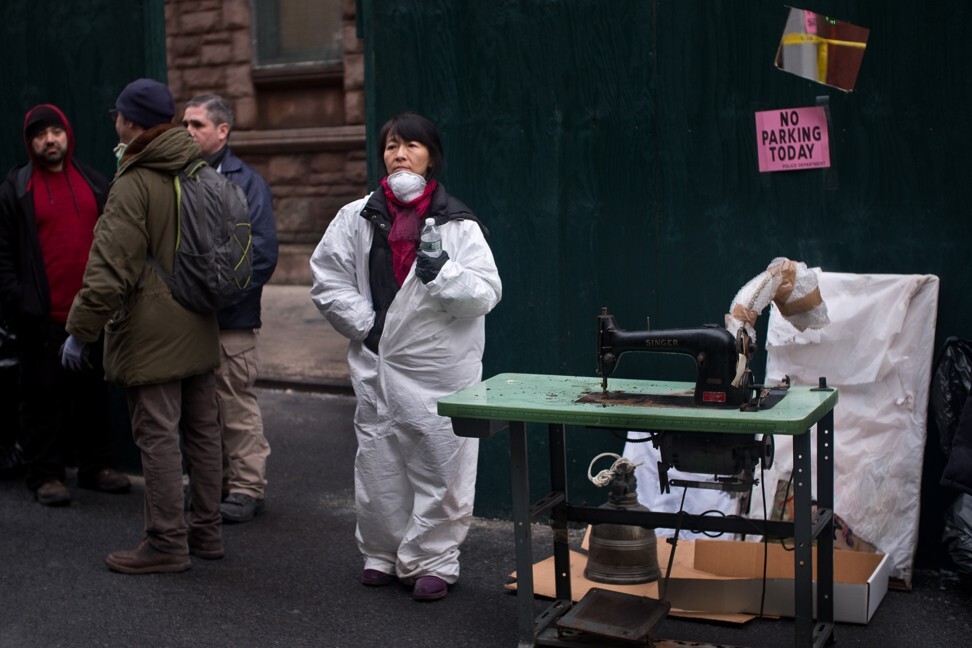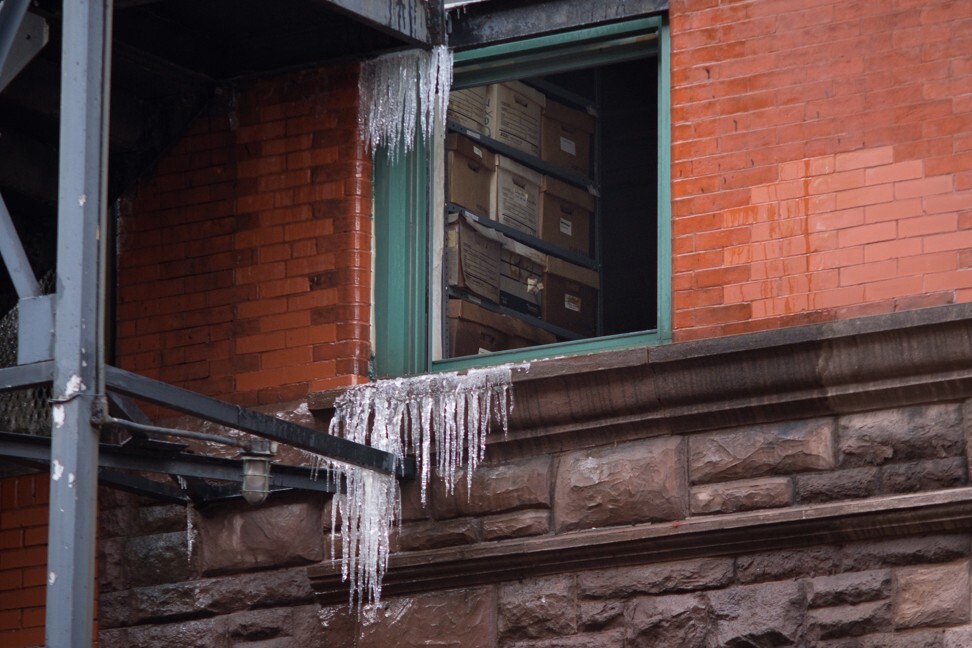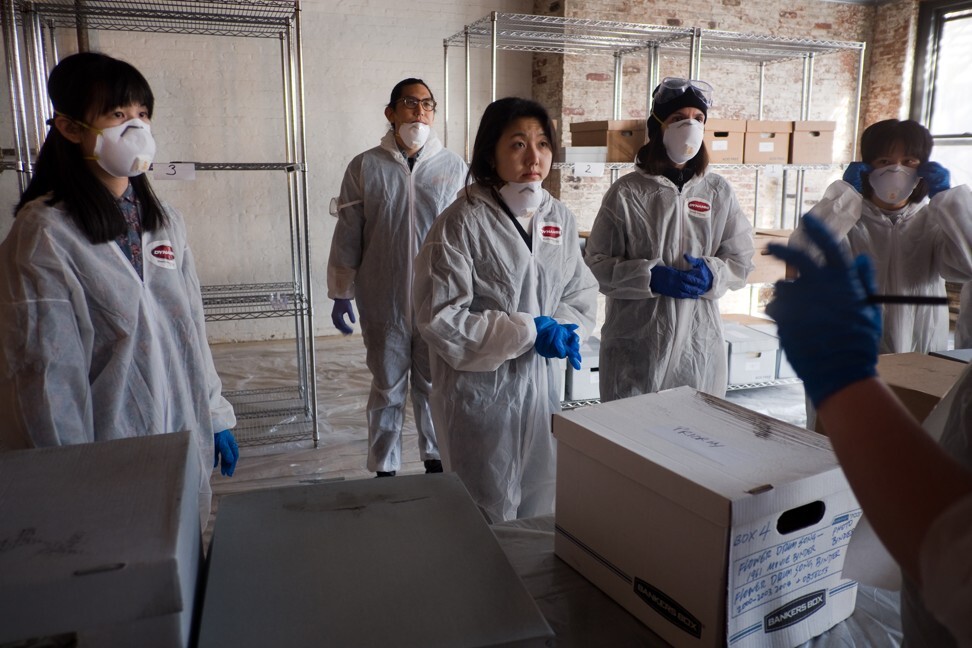When fire ravaged the Chinatown building containing the museum archives in January, it was feared the stories they told would be lost forever
Alan Chin Published: 20 Jun, 2020
Standing on the corner of Bayard and Mulberry streets in New York’s Chinatown on March 8, Nancy Yao Maasbach, president of the Museum of Chinese in America, and Yue Ma, Moca’s director of collections and research, are dressed head to toe in white Tyvek hazmat suits, with N95 masks covering their faces.
Ma and Yao Maasbach are protecting themselves from mould, asbestos and other toxins that could have been released by the massive fire that consumed the 19th century former public school housing the museum’s archives at 70 Mulberry Street on the night of January 23, two days before Lunar New Year.
The museum itself was left unscathed, four blocks away, on Centre Street, in a modern space designed by Chinese-American architect Maya Lin. But shock ripped through the neighbourhood and social media as initial reports suggested that Moca’s archives – more than 85,000 historic artefacts and documents stored at 70 Mulberry Street, the museum’s previous home – had been destroyed.
The collection included thousands of photographs, out-of-print Chinese-American newspapers and signage from old stores. There were artefacts from laundries, sweatshops and restaurants, as well as “paper son” documents of Chinese men who had evaded the United States’ Chinese Exclusion Act of 1882 by posing as relatives of American citizens.
“This isn’t only about Asian art,” says Yao Maasbach. “We are part of the American narrative.
”

Yue Ma (in protective gear), of the Museum of Chinese in America, with items recovered from the building, including a sewing machine once used in a sweatshop in New York’s Chinatown. Photo: Alan Chin
Charlie Lai and Jack Tchen were young men in the 1970s, members of a new generation of Chinese-Americans fluent in English and educated at prestigious universities, often on scholarships. Lai was born in Hong Kong and immigrated with his family to New York in the late 60s, when he was nine years old. Tchen was American-born Chinese by way of Madison, Wisconsin.
Both were activists swept up in the cultural and political tumult of the 60s and 70s, and saw opportunities for Chinese-Americans to assert themselves. The pair joined a pioneering Asian-American arts and political organisation called Basement Workshop and began to amass documents and artefacts.
“People thought of me as a librarian for a long time, and not in a good way,” says Tchen.
Lai says, “Stuff was being thrown out into the streets: photographs, letters, leather suitcases. The new people coming into Chinatown had no idea. Nobody cared before, but once somebody looks at it, it becomes valuable.”
The pair formed the Chinatown History Project, in 1980, moving into 70 Mulberry Street four years later with the initial goal of interviewing and recording the senior generation – the labourers who had toiled all their working lives in laundries and restaurants, and the seamstresses of the then-ubiquitous sweatshops in Chinatown. Their early exhibitions were held in a senior citizens’ centre and a public library. “Old-timers would walk up the stairs and start telling stories about the people in the photos,” Tchen recalls.
For almost a century up to 1965, New York’s Chinatown had been an ethnic enclave of a few thousand people, mostly men, but with the lifting of the national-origins quota for immigration and the commitment to family reunification explicit in the new laws, the Chinese population exploded.
In 1991, the Chinatown History Project changed its name to the Chinatown History Museum and then, in 1995, to the Museum of Chinese in America. In 2009, it moved into its present, much-larger space on Centre Street, driven by its expanding archives and, as Lai says, the need for “people to buy this idea that the museum can be nationally respectable. Otherwise it’s just a dead thing”.

Moca co-founder Charlie Lai. Photo: Alan Chin
Both Lai and Tchen eventually left Moca to pursue other projects. Lai led several community organisations and worked for the city government while Tchen became a university professor. Neither is currently involved in the museum’s operations, but when word reached them on a cold January night that 70 Mulberry Street was on fire, their responses were visceral.
“I was thinking of Paris and Notre Dame,” Tchen says, referring to the fire that ravaged the iconic French landmark last year. And Lai promised to “move heaven and hell” to recover Moca’s collections.
After the January 23 fire, New York Mayor Bill de Blasio visited the site, declaring that “70 Mulberry Street is a pillar of Chinatown, and I stand with the entire community as recovery efforts continue. We will do everything in our power to help these incredible organisations rebuild and bring this historic building back to life”.
Workers erected a wooden fence, closing off Bayard and Mulberry streets, and on January 28, five days after the fire, a group of stern-faced men gathered at the burnt-out site. They represented myriad city agencies: the Department of Citywide Administrative Services (DCAS); Housing, Preservation and Development (HPD); the Department of Buildings (DOB); the Department of Environmental Protection (DEP); and the police and fire services.
Balford Davis, a supervising demolition inspector for HPD, said, “Private contractors will take free-standing walls out, the building itself is still sound.” One of those contractors, who refused to give his name, said, “They don’t know what to do yet, but they are very concerned with the artefacts. Every little piece will be saved.”

Chinatown residents look up at the fire-ravaged building. Photo: Alan Chin
The museum started a GoFundMe that eventually raised more than US$450,000 from 1,800 individual donors, with much of that doubled by a matching fund. Yao Maasbach also received an unsolicited cheque for US$50,000 from the Museum of Food and Drink.
Yuh-Line Niou, New York State assemblywoman for the neighbourhood and the first Chinese-American to be elected to that position, says, “I called the mayor. I was calling all the organisations to connect, to give me a rundown of how to respond to this with which city agencies. A city-owned building has to be managed in the city-owned way. But within 48 hours we made sure that people could operate.”
Moca was informed that the operation to remove its items from the building would begin on January 29, and to prepare, dozens of volunteers arrived to process the objects: former staff, artists, museum employees and members of Moca’s extensive network.

Quintin Haynes (left), of the Department of Citywide Administrative Services, with Moca’s Nancy Yao Maasbach and Yue Ma. Photo: Alan Chin
Quintin Haynes, executive deputy commissioner of DCAS, led the effort at 70 Mulberry Street, where a small group of contractors in full hazmat suits went into the building and removed archive boxes one at a time. Ma, as chief curator of the museum, opened each box as it came out to note the contents and assess their condition.
Some were judged in good enough shape to be passed to the waiting volunteers. Water-damaged documents and photographs were placed into a special freezer truck to be flash-frozen and then flash-thawed, the moisture turning directly from ice into steam without first becoming water.
Several hundred cardboard boxes emerged under the lenses of waiting television cameras. Irreplaceable copies of the Chinese-American Times, an early immigrant newspaper, were intact. Costumes donated by a Chinese opera troupe were smoke-infused but undamaged.
Lai and Tchen stood behind a police barricade, quietly watching the operation in progress. They were joined by Ava Chin, who had donated to Moca her great-grandfather’s 1914 steamship ticket as well as his Exclusion-era identification papers.
Back at the museum, volunteers threw away waterlogged wrappings and carefully relabelled, photographed and recatalogued each item. Volunteer Lindsey Hobbs, head of conservation and preservation at New York City Municipal Archives, said, “Seven-hundred items out, they looked pretty good. Wet, but not terrible.”

A papier mache sculpture made by survivors of the 1993 Golden Venture shipwreck while they were held in detention in the US is rescued from the fire-damaged building. Photo: Alan Chin
The recovery continued on January 31. Some objects, such as the papier mache sculptures made by survivors of the 1993 Golden Venture shipwreck, detained for years by US immigration authorities, were fragile and considered most at risk but had sustained only minor damage. Yao Maasbach’s mood began to shift from fear and trepidation to guarded optimism, in the belief that the legacy of what she called “the history of people excluded” would be preserved.
Over the following days and weeks, as the initial euphoria wore off, anxiety returned. Frustration gave way to stirrings of panic. By late February, there had been no more action from the city nor were there any concrete plans to save the items that still remained at 70 Mulberry Street.
Icicles hung from the eaves as the invaluable objects continued to be exposed to the elements and deteriorate. News reports had recorded the joyful sights of the first items to be saved, but as Ma clarifies, “We only got 20 per cent out, and it all should have been done in 48 to 72 hours. Nothing was really dry, and time was important.”
Amy Chin, a community activist, historian and genealogist, said the “recovery is taking too long now that it’s no longer in the spotlight. If it had been the Met [New York’s premier arts institution], all the contents would’ve been rescued by now”.

A part of Moca’s archives exposed to the elements on January 30. Photo: Alan Chin
On February 25, Moca invited a small group of “neighbours and community leaders” to discuss the situation. A projection on the conference-room screen declaring “Our Stories Count!” in large, bold type welcomed the dozen or so attendees, who included veterans of city agencies as well as community activists and businesspeople. Yao Maasbach made an impassioned plea to get the remainder of the historic items out of 70 Mulberry Street. “There are 350 family collections,” she said, “our identity is in that collection.”
She stressed the museum’s commitment to continuing and completing a digital edition of the archive, which they had begun before the fire. She was grateful that “every major museum has helped. People do care about our stories and our history”. Plans were made for a public march and rally to bring the museum’s plight back into the public eye.
Moca was informed the next day that the recovery would be completed soon. According to the museum’s public statement, “the constant drumbeat to save Moca’s collections was heard loud and clear in City Hall. This is not just a victory for Moca. This is a victory for the entire community, for Chinatown, for every family whose life stories enrich the American narrative.”
Haynes and his team returned at dawn on March 8. Forming a human chain, workers were able to remove items much faster than before. These included large street and window signs from defunct Chinatown businesses, once the visual landscape of the neighbourhood. By the end of the day, the long-delayed task had been completed.

Volunteers assess a box recovered from the building. Photo: Alan Chin
The museum was fortunate that more than 95 per cent of its remaining items were recovered on March 8, because the coronavirus would soon sweep through New York, leading Moca to close its doors to the public on March 13.
Like other institutions, Moca has scrambled to adapt to the pandemic by increasing its digital programmes. It has also launched an initiative called the “OneWorld Covid-19 Special Collection”, asking Chinese-Americans to submit oral histories, texts, photographs, videos and other items documenting their pandemic experience, including the rise in hate crimes against Asian-Americans.
“Moca stands against racism,” says Yao Maasbach, “and works tirelessly to share these painful episodes and document the occurrences.”
Beset by multiple crises this Year of the Metal Rat, the museum’s mission has, perhaps, come full circle: as an activist project documenting the struggles of the Chinese community. Reflecting on what Moca ultimately means to him, Lai says, “This is our history, living history, immigrants, Americans, all of us. To do right by our forebears.”

Alan Chin was born and raised in New York City’s Chinatown. Since 1996, he has worked in China, the former Yugoslavia, Afghanistan, Egypt, Iraq, Central Asia, and Ukraine, as well as extensively in the United States. He is a contributing photographer to The New York Times and many other publications, an Adjunct Professor at the Columbia University Graduate School of Journalism, and his work is in the collections of the Museum Of Modern Art and the Detroit Institute of Art. The New York Times twice nominated Alan for the Pulitzer Prize for coverage of the Kosovo conflict in 1999 and 2000.
Yuh-Line Niou, New York State assemblywoman for the neighbourhood and the first Chinese-American to be elected to that position, says, “I called the mayor. I was calling all the organisations to connect, to give me a rundown of how to respond to this with which city agencies. A city-owned building has to be managed in the city-owned way. But within 48 hours we made sure that people could operate.”
Moca was informed that the operation to remove its items from the building would begin on January 29, and to prepare, dozens of volunteers arrived to process the objects: former staff, artists, museum employees and members of Moca’s extensive network.

Quintin Haynes (left), of the Department of Citywide Administrative Services, with Moca’s Nancy Yao Maasbach and Yue Ma. Photo: Alan Chin
Quintin Haynes, executive deputy commissioner of DCAS, led the effort at 70 Mulberry Street, where a small group of contractors in full hazmat suits went into the building and removed archive boxes one at a time. Ma, as chief curator of the museum, opened each box as it came out to note the contents and assess their condition.
Some were judged in good enough shape to be passed to the waiting volunteers. Water-damaged documents and photographs were placed into a special freezer truck to be flash-frozen and then flash-thawed, the moisture turning directly from ice into steam without first becoming water.
Several hundred cardboard boxes emerged under the lenses of waiting television cameras. Irreplaceable copies of the Chinese-American Times, an early immigrant newspaper, were intact. Costumes donated by a Chinese opera troupe were smoke-infused but undamaged.
Lai and Tchen stood behind a police barricade, quietly watching the operation in progress. They were joined by Ava Chin, who had donated to Moca her great-grandfather’s 1914 steamship ticket as well as his Exclusion-era identification papers.
Back at the museum, volunteers threw away waterlogged wrappings and carefully relabelled, photographed and recatalogued each item. Volunteer Lindsey Hobbs, head of conservation and preservation at New York City Municipal Archives, said, “Seven-hundred items out, they looked pretty good. Wet, but not terrible.”

A papier mache sculpture made by survivors of the 1993 Golden Venture shipwreck while they were held in detention in the US is rescued from the fire-damaged building. Photo: Alan Chin
The recovery continued on January 31. Some objects, such as the papier mache sculptures made by survivors of the 1993 Golden Venture shipwreck, detained for years by US immigration authorities, were fragile and considered most at risk but had sustained only minor damage. Yao Maasbach’s mood began to shift from fear and trepidation to guarded optimism, in the belief that the legacy of what she called “the history of people excluded” would be preserved.
Over the following days and weeks, as the initial euphoria wore off, anxiety returned. Frustration gave way to stirrings of panic. By late February, there had been no more action from the city nor were there any concrete plans to save the items that still remained at 70 Mulberry Street.
Icicles hung from the eaves as the invaluable objects continued to be exposed to the elements and deteriorate. News reports had recorded the joyful sights of the first items to be saved, but as Ma clarifies, “We only got 20 per cent out, and it all should have been done in 48 to 72 hours. Nothing was really dry, and time was important.”
Amy Chin, a community activist, historian and genealogist, said the “recovery is taking too long now that it’s no longer in the spotlight. If it had been the Met [New York’s premier arts institution], all the contents would’ve been rescued by now”.

A part of Moca’s archives exposed to the elements on January 30. Photo: Alan Chin
On February 25, Moca invited a small group of “neighbours and community leaders” to discuss the situation. A projection on the conference-room screen declaring “Our Stories Count!” in large, bold type welcomed the dozen or so attendees, who included veterans of city agencies as well as community activists and businesspeople. Yao Maasbach made an impassioned plea to get the remainder of the historic items out of 70 Mulberry Street. “There are 350 family collections,” she said, “our identity is in that collection.”
She stressed the museum’s commitment to continuing and completing a digital edition of the archive, which they had begun before the fire. She was grateful that “every major museum has helped. People do care about our stories and our history”. Plans were made for a public march and rally to bring the museum’s plight back into the public eye.
Moca was informed the next day that the recovery would be completed soon. According to the museum’s public statement, “the constant drumbeat to save Moca’s collections was heard loud and clear in City Hall. This is not just a victory for Moca. This is a victory for the entire community, for Chinatown, for every family whose life stories enrich the American narrative.”
Haynes and his team returned at dawn on March 8. Forming a human chain, workers were able to remove items much faster than before. These included large street and window signs from defunct Chinatown businesses, once the visual landscape of the neighbourhood. By the end of the day, the long-delayed task had been completed.

Volunteers assess a box recovered from the building. Photo: Alan Chin
The museum was fortunate that more than 95 per cent of its remaining items were recovered on March 8, because the coronavirus would soon sweep through New York, leading Moca to close its doors to the public on March 13.
Like other institutions, Moca has scrambled to adapt to the pandemic by increasing its digital programmes. It has also launched an initiative called the “OneWorld Covid-19 Special Collection”, asking Chinese-Americans to submit oral histories, texts, photographs, videos and other items documenting their pandemic experience, including the rise in hate crimes against Asian-Americans.
“Moca stands against racism,” says Yao Maasbach, “and works tirelessly to share these painful episodes and document the occurrences.”
Beset by multiple crises this Year of the Metal Rat, the museum’s mission has, perhaps, come full circle: as an activist project documenting the struggles of the Chinese community. Reflecting on what Moca ultimately means to him, Lai says, “This is our history, living history, immigrants, Americans, all of us. To do right by our forebears.”

Alan Chin was born and raised in New York City’s Chinatown. Since 1996, he has worked in China, the former Yugoslavia, Afghanistan, Egypt, Iraq, Central Asia, and Ukraine, as well as extensively in the United States. He is a contributing photographer to The New York Times and many other publications, an Adjunct Professor at the Columbia University Graduate School of Journalism, and his work is in the collections of the Museum Of Modern Art and the Detroit Institute of Art. The New York Times twice nominated Alan for the Pulitzer Prize for coverage of the Kosovo conflict in 1999 and 2000.
No comments:
Post a Comment